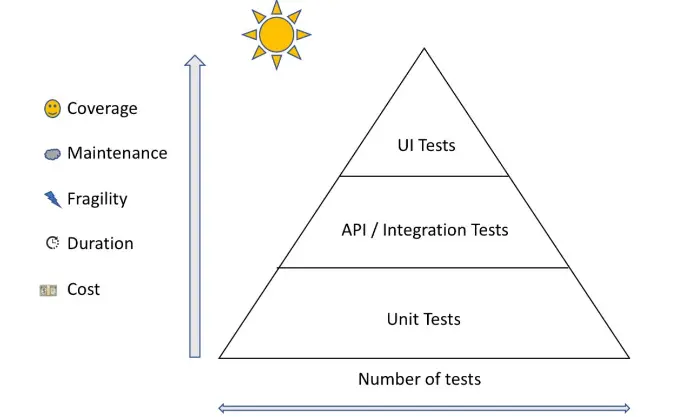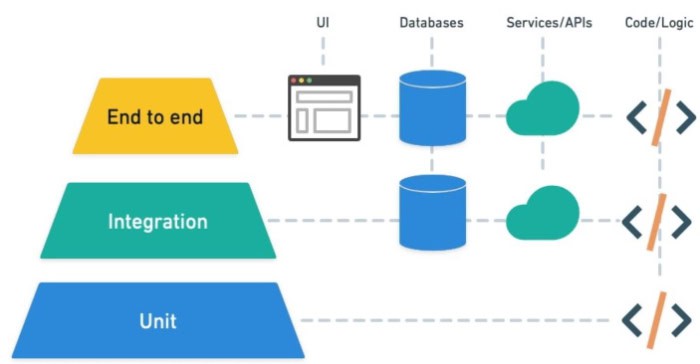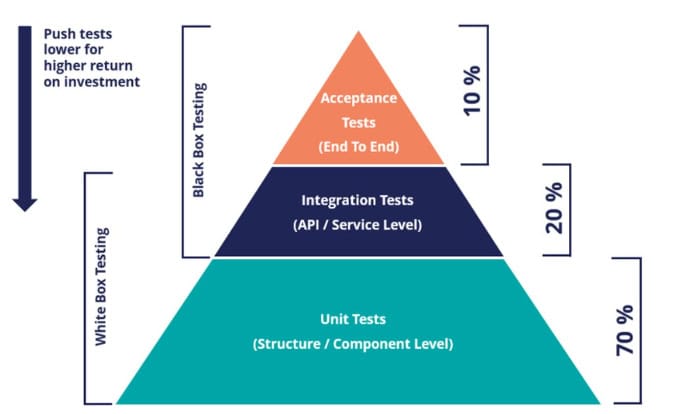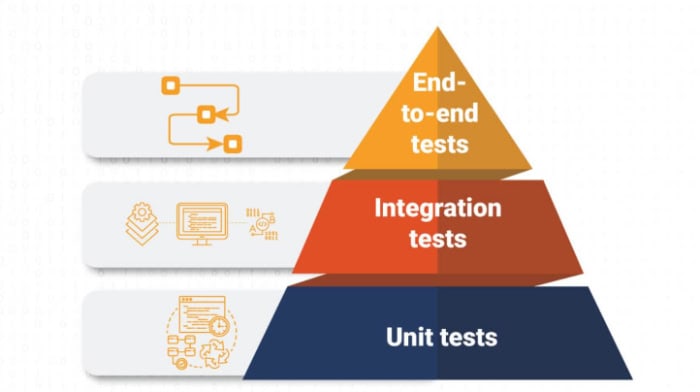The testing pyramid is a well-liked architecture that is frequently used to structure an effective and efficient testing method. It is not surprising that testing has evolved to be an essential step in the software development process, given how rapidly the area of software development has developed over the past several decades. The three testing types represented by the distinct stages of the testing pyramid are unit tests, integration tests, and end-to-end tests.
The idea behind the testing pyramid is simple: it offers a systematic method of testing that begins with unit tests, continues with integration tests, and concludes with end-to-end tests. The testing pyramid encourages a testing culture that may boost stakeholders’ trust, including that of consumers and investors. Like the testing pyramid, there is also web application testing used by developers. Developers may verify the quality of their code while cutting down on the time and expense of testing by prioritizing tests according to their priority and risk.
While being widely utilized, the testing pyramid has its drawbacks. End-to-end tests may be very difficult to build and manage, and writing and maintaining them might require much effort. Testing may also be costly, particularly for smaller firms with limited resources. However, the advantages of employing a thorough testing method outweigh the difficulties. The testing pyramid continues to be a crucial tool for any software development team wishing to guarantee the caliber of their code.
What is the Testing Pyramid?
A framework that aids developers in organizing their testing approach is the testing pyramid. Three tiers make up the pyramid, and each layer stands for a particular kind of examination.
Each pyramid tier is intended to build on the one before it, providing a solid foundation for testing. The tiers are:
Unit Tests
Unit tests are at the base of the pyramid. They are brief tests that concentrate on specific parts or sections of code. These tests may be of use to test everything from functions and methods to classes and modules.
This ensures that each code unit performs as intended. As developers commonly automate and create them, unit tests may be quickly and regularly executed.
Integrity Tests
Integrity checks are at the center of the pyramid. Integration tests evaluate how various pieces of code interact.
Unit tests are less thorough than integration tests, which may test things like databases, external services, and API endpoints. Integration tests can be either automated or manual, based on how complicated the system under test is. Hence, you can do a comparison of test automation tools and find the perfect one for you!
End-to-End Tests
At the summit of the pyramid are tests from beginning to end. End-to-end tests examine every aspect of the system, including all of its parts and their interactions.
The most thorough kind of testing, and end-to-end tests, are done by the team. These tests are done to identify problems that unit and integration tests might overlook.
Use of the Testing Pyramid
Now that we are aware of what the testing pyramid is let’s discuss its application. Prioritizing tests according to their significance and the degree of difficulty is the key to implementing the testing pyramid efficiently.
Prioritizing tests depending on their relevance and amount of risk is the key to implementing the testing pyramid efficiently. In other words, you should concentrate your testing efforts on the system components that are most crucial and provide the greatest risk of failure. Similar to the testing pyramid, you can utilize Web application testing, which is used by developers to ensure the application is free of bugs, errors, and security vulnerabilities.
- Start with unit tests
- Move to integration tests
- Finish with end-to-end tests
Unit tests should be the first thing you write and execute since they are the simplest and quickest tests to create. Most errors and issues you may find early on in the development process by starting with unit tests, saving time and lowering the chance of introducing bugs into the codebase.
After creating unit tests for all of your system’s essential parts, you may proceed to integration tests. The interactions and cooperation of the components should be the main subject of integration testing. You may find problems that unit tests may miss if you test the integration of the components.
End-to-end testing might be of use as your final step to complete the process. End-to-end tests should examine the whole operation of the system. These tests should be of use to identify any problems that unit and integration tests could have overlooked. End-to-end tests might take a long time and money to conduct since they are the most thorough kind of test. You should use them occasionally and focus your efforts on the most critical parts of your system.
See Also: 6 Ways To Fix The Requested Operation Requires Elevation Error
Benefits of Testing Pyramid
The testing pyramid offers several advantages, including the following.
- Reduced testing time: Time spent testing may be cut down by selecting tests according to their priority and level of risk. This cuts down on testing expenses and saves time.
- Better quality: The testing pyramid ensures that every system component is adequately tested, lowering the possibility of errors and other problems.

- Faster feedback: Quick feedback is possible because unit tests are speedy and automated, allowing developers to receive comments on their code nearly immediately. They are able to identify problems earlier in the development process, which cuts down on the expense and time needed to address problems.
- Boosted self-assurance: By employing a thorough testing technique, developers can feel more certain about the caliber of their code. As a result, stakeholders like consumers and investors may become more confident.
- Improved maintainability: As unit tests emphasize in the testing pyramid, developers may more easily maintain their software. This is because unit tests verify that updates to the codebase don’t trigger the emergence of fresh defects or problems.
Disadvantages of the Testing Pyramid
Despite the testing pyramid’s numerous advantages, there are also some drawbacks. Using the testing pyramid presents certain difficulties, such as:
- Complexity: The creation and upkeep of tests can be time-consuming and difficult. This is particularly true for end-to-end tests, which can complicate procedures and need significant time and money to build and maintain.
- Cost: Testing may be pricey, particularly when using manual or end-to-end testing. For smaller businesses with fewer resources, this can be a major expense.

- Tooling: Specialized equipment and knowledge are needed to create and manage tests. Organizations that lack the resources or knowledge necessary to develop and sustain an all-encompassing testing plan may find this to be a difficulty.
FAQs
How do unit tests work?
A unit test is a test that examines a single component of an application separately. These tests, which developers frequently create, test certain pieces of code, such as particular functions or methods.
How do integration tests work?
Integration tests examine how various parts of a program interact with one another. These tests, which developers frequently author, evaluate the interactions between various pieces of code.
What does end-to-end testing entail?
End-to-end tests examine an application's whole from beginning to end. These tests, which imitate actual situations like user interactions with the program, quality assurance (QA) engineers make them.
What makes the testing pyramid so crucial?
The testing pyramid is crucial because it offers a systematic method of testing that ranks tests according to their significance and risk. This minimizes the time and expense of testing while ensuring that the most important parts of an application are accurate.
Conclusion
The testing pyramid is an effective structure for arranging your testing plan in light of the preceding. A thorough testing technique provides significantly more advantages than disadvantages, even though the testing pyramid has certain drawbacks. You may cut testing costs and time while assuring the quality of your code by prioritizing tests based on their significance and risk. Hence, whether you work alone or with a huge team of developers, consider utilizing the testing pyramid to verify the code’s quality.
See Also: Desktop Application Development Process | Guide For Beginners

Mayank Parmar is a journalist covering technology news, but with a strong focus on Microsoft and Windows related stories.





